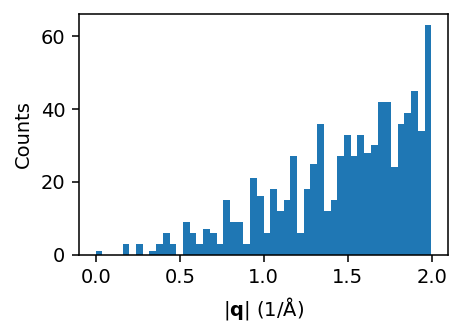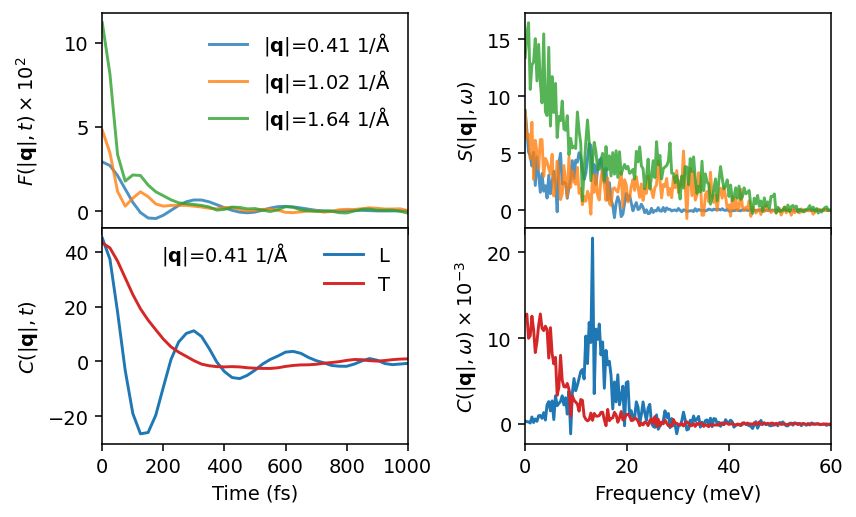Dynamic properties of liquid Al#
This example demonstrate the analysis of the dynamics of liquid aluminium via the dynamic structure factor as well as current correlation functions. Here, we use a rather small simulation cell, a short trajectory, and few q-points in order to make the tutorial run fast. In practice one needs to tune these parameters as well as the parameters used when calling dynasor for optimal results.
This example uses a trajectory that can be downloaded from zenodo via
wget https://zenodo.org/records/10013486/files/dumpT1400.NVT.atom.velocity
or generated from scratch by running lammps using the input files provided.
[1]:
import numpy as np
import matplotlib.pyplot as plt
from dynasor import compute_dynamic_structure_factors, Trajectory
from dynasor.qpoints import get_spherical_qpoints
from dynasor.post_processing import get_spherically_averaged_sample_binned
[2]:
# set log level
from dynasor.logging_tools import set_logging_level
set_logging_level('INFO')
Set up the trajectory for reading#
dynasor supports multiple different trajectory formats via internal readers as well as via mdanalysis and ase. Here, we use the internal lammps reader.
[3]:
trajectory_filename = 'dumpT1400.NVT.atom.velocity'
traj = Trajectory(
trajectory_filename,
trajectory_format='lammps_internal',
frame_stop=5000)
INFO 2025-08-25 10:36:46: Assuming the trajectory has the default length unit (Ångström), since no unit was specified.
INFO 2025-08-25 10:36:46: Assuming the trajectory has the default time unit (fs), since no unit was specified.
INFO 2025-08-25 10:36:46: Trajectory file: dumpT1400.NVT.atom.velocity
INFO 2025-08-25 10:36:46: Total number of particles: 2048
INFO 2025-08-25 10:36:46: Number of atom types: 1
INFO 2025-08-25 10:36:46: Number of atoms of type X: 2048
INFO 2025-08-25 10:36:46: Simulation cell (in Angstrom):
[[34.032 0. 0. ]
[ 0. 34.032 0. ]
[ 0. 0. 34.032]]
A short summary of the content of the traj object can be obtained via the display (in notebooks) or print (in notebooks or scripts) commands.
[4]:
display(traj)
Trajectory
| Field | Value | File name | dumpT1400.NVT.atom.velocity |
|---|---|
| Number of atoms | 2048 |
| Cell metric | [[34.032 0. 0. ] [ 0. 34.032 0. ] [ 0. 0. 34.032]] |
| Frame step | 1 |
| Atom types | ['X'] |
Select q-points to sample#
Next we specify which q-points should be sampled. Here, we consider q-points on a three-dimensional mesh up to a maximum of |q| = 2 rad/Å with the maximum number of q-points set to 2000.
Note here that the units of q-points are technically rad/Å, however most commonly people will just denote this as 1/Å.
[5]:
q_points = get_spherical_qpoints(traj.cell, q_max=2, max_points=5000)
INFO 2025-08-25 10:36:46: Pruning q-points from the range 1.7 < |q| < 2
INFO 2025-08-25 10:36:46: Pruned from 5377 q-points to 5031
It is useful to generate a histogram to check how many \(\mathbf{q}\)-points are sampled as a function of \(|\mathbf{q}|\).
[6]:
plt.figure(figsize=(3.4, 2.5), dpi=140)
plt.hist(np.linalg.norm(q_points, axis=1), bins=30)
plt.xlabel(r'$|\mathbf{q}|$ (rad/Å)')
plt.ylabel('Counts')
plt.tight_layout()

Run calculation of correlation functions#
We are now all set for calculating the dynamic structure factor as well as the current correlation functions (by setting include_currents=True). To obtain the correct units, the spacing between the frames (dt) must be specified in units of femtoseconds.
The following cell should take a few minutes to run on a common work station.
[7]:
%%time
sample_raw = compute_dynamic_structure_factors(
traj, q_points, dt=25.0, window_size=500,
window_step=50, calculate_currents=True)
INFO 2025-08-25 10:36:46: Spacing between samples (frame_step): 1
INFO 2025-08-25 10:36:46: Time between consecutive frames in input trajectory (dt): 25.0 fs
INFO 2025-08-25 10:36:46: Time between consecutive frames used (dt * frame_step): 25.0 fs
INFO 2025-08-25 10:36:46: Time window size (dt * frame_step * window_size): 12500.0 fs
INFO 2025-08-25 10:36:46: Angular frequency resolution: dw = 0.000251 rad/fs = 0.165 meV
INFO 2025-08-25 10:36:46: Maximum angular frequency (dw * window_size): 0.125664 rad/fs = 82.713 meV
INFO 2025-08-25 10:36:46: Nyquist angular frequency (2pi / frame_step / dt / 2): 0.125664 rad/fs = 82.713 meV
INFO 2025-08-25 10:36:46: Calculating current (velocity) correlations
INFO 2025-08-25 10:36:46: Number of q-points: 5031
INFO 2025-08-25 10:37:06: Processing window 0 to 500
INFO 2025-08-25 10:37:47: Processing window 1000 to 1500
INFO 2025-08-25 10:38:28: Processing window 2000 to 2500
INFO 2025-08-25 10:39:09: Processing window 3000 to 3500
INFO 2025-08-25 10:39:50: Processing window 4000 to 4500
CPU times: user 26min 33s, sys: 2.29 s, total: 26min 35s
Wall time: 3min 28s
As in the case of the trajectory, we can use the display or print commands to obtain a quick summary of the Sample object returned by the compute_dynamic_structure_factors function.
[8]:
display(sample_raw)
DynamicSample
Simulation
| Name | Content |
|---|---|
| Angular frequency resolution | 0.0002513274122871834 |
| Atom types | ['X'] |
| Cell | [[34.032 0. 0. ] [ 0. 34.032 0. ] [ 0. 0. 34.032]] |
| Maximum time lag | 12500.0 |
| Number of frames | 5000 |
| Particle counts | {'X': 2048} |
| Time between frames | 25.0 |
Dimensions
| Field | Size |
|---|---|
| omega | (501,) |
| q_points | (5031, 3) |
| time | (501,) |
History
| Function | Field | Content |
|---|---|---|
| compute_dynamic_structure_factors | dt | 25.0 |
| window_size | 500 | |
| window_step | 50 | |
| calculate_currents | True | |
| calculate_incoherent | False | |
| date_time | 2025-08-25T10:40:14 | |
| username | erhart | |
| hostname | pieweack | |
| dynasor_version | 2.2 |
Spherical average over q-points#
It is often of interest to take a spherical average over q-space, in particular in the case of liquids. To this end, we use the get_spherically_averaged_sample_binned function.
[9]:
sample_averaged = get_spherically_averaged_sample_binned(sample_raw, num_q_bins=30)
WARNING 2025-08-25 10:40:14: No q-points for bin 1
WARNING 2025-08-25 10:40:14: No q-points for bin 2
WARNING 2025-08-25 10:40:14: No q-points for bin 1
WARNING 2025-08-25 10:40:14: No q-points for bin 2
WARNING 2025-08-25 10:40:14: No q-points for bin 1
WARNING 2025-08-25 10:40:14: No q-points for bin 2
WARNING 2025-08-25 10:40:14: No q-points for bin 1
WARNING 2025-08-25 10:40:14: No q-points for bin 2
WARNING 2025-08-25 10:40:14: No q-points for bin 1
WARNING 2025-08-25 10:40:14: No q-points for bin 2
WARNING 2025-08-25 10:40:14: No q-points for bin 1
WARNING 2025-08-25 10:40:14: No q-points for bin 2
WARNING 2025-08-25 10:40:14: No q-points for bin 1
WARNING 2025-08-25 10:40:14: No q-points for bin 2
WARNING 2025-08-25 10:40:14: No q-points for bin 1
WARNING 2025-08-25 10:40:14: No q-points for bin 2
WARNING 2025-08-25 10:40:14: No q-points for bin 1
WARNING 2025-08-25 10:40:14: No q-points for bin 2
WARNING 2025-08-25 10:40:14: No q-points for bin 1
WARNING 2025-08-25 10:40:14: No q-points for bin 2
WARNING 2025-08-25 10:40:14: No q-points for bin 1
WARNING 2025-08-25 10:40:14: No q-points for bin 2
WARNING 2025-08-25 10:40:14: No q-points for bin 1
WARNING 2025-08-25 10:40:14: No q-points for bin 2
Visualize dynamic structure factor#
We can now visualize the isotropically averaged dynamic structure factor \(S(|\mathbf{q}|, \omega)\), for example, in the form of a heatmap on the momentum-frequency plane. Note that the lower cutoff of the q-axis is set by the size of the supercell.
[10]:
from dynasor.units import radians_per_fs_to_meV as conversion_factor # conversion from 1/fs to meV
sample_averaged.omega *= conversion_factor
[11]:
fig, ax = plt.subplots(figsize=(3.4, 2.5), dpi=140)
ax.pcolormesh(sample_averaged.q_norms, sample_averaged.omega,
sample_averaged.Sqw_coh.T,
cmap='Blues', vmin=0, vmax=4)
ax.text(0.05, 0.85, r'$S(|\mathbf{q}|, \omega)$', transform=ax.transAxes,
bbox={'color': 'white', 'alpha': 0.8, 'pad': 3})
ax.plot([0, 1], [0, 36], alpha=0.5, ls='--', c='0.3', lw=2)
ax.set_xlabel(r'$|\mathbf{q}|$ (rad/Å)')
ax.set_ylabel('Energy (meV)')
ax.set_ylim([0, 60])
fig.tight_layout()

Visualize current correlations#
Next we plot the longitudinal and transverse current correlation heatmaps. In the longitudinal current correlation function one can observe the longitudinal branch that is also visible in the dynamic structure factor. The transverse current correlation functions also reveals a transverse mode.
[12]:
fig, axes = plt.subplots(figsize=(3.4, 3.8), nrows=2, dpi=140,
sharex=True, sharey=True)
ax = axes[0]
ax.pcolormesh(sample_averaged.q_norms, sample_averaged.omega,
sample_averaged.Clqw.T, cmap='Reds', vmin=0, vmax=4000)
ax.text(0.05, 0.85, r'$C_L(|\mathbf{q}|, \omega)$', transform=ax.transAxes,
bbox={'color': 'white', 'alpha': 0.8, 'pad': 3})
ax.plot([0, 1.5], [0, 54], alpha=0.5, ls='--', c='0.3', lw=2)
ax = axes[1]
ax.pcolormesh(sample_averaged.q_norms, sample_averaged.omega,
sample_averaged.Ctqw.T, cmap='Oranges', vmin=0, vmax=4000)
ax.text(0.05, 0.85, r'$C_T(|\mathbf{q}|, \omega)$', transform=ax.transAxes,
bbox={'color': 'white', 'alpha': 0.8, 'pad': 3})
ax.plot([0, 1.5], [0, 25], alpha=0.5, ls='--', c='0.3', lw=2)
ax.set_xlabel(r'$|\mathbf{q}|$ (rad/Å)')
ax.set_ylabel('Energy (meV)', y=1)
ax.set_ylim([0, 59])
fig.tight_layout()
plt.subplots_adjust(hspace=0)

Slices in |q|-space#
Finally, we can also inspect individually slices as demonstrated in the following cell.
[13]:
q_inds = [6, 15, 24] # slices in heatmap
fig, axes = plt.subplots(figsize=(6.2, 3.8), nrows=2, ncols=2,
sharex='col', dpi=140)
#-----
# Intermediate scattering function and dynamic structure factor
for q_ind in q_inds:
label = fr'$|\mathbf{{q}}|$={sample_averaged.q_norms[q_ind]:.2f} rad/Å'
axes[0][0].plot(sample_averaged.time, sample_averaged.Fqt_coh[q_ind, :] * 100,
label=label, alpha=0.8)
axes[0][1].plot(sample_averaged.omega, sample_averaged.Sqw_coh[q_ind, :],
label=label, alpha=0.8)
ax = axes[0][0]
ax.set_ylabel(r'$F(|\mathbf{q}|, t) \times 10^2$')
ax.legend(frameon=False)
ax = axes[0][1]
ax.set_ylabel(r'$S(|\mathbf{q}|, \omega)$')
#-----
# Current correlation functions
q_ind = q_inds[0]
axes[1][0].plot(sample_averaged.time, sample_averaged.Clqt[q_ind, :],
label='L')
axes[1][0].plot(sample_averaged.time, sample_averaged.Ctqt[q_ind, :],
label='T', c='C3')
axes[1][1].plot(sample_averaged.omega, sample_averaged.Clqw[q_ind, :] / 1000,
label='L')
axes[1][1].plot(sample_averaged.omega, sample_averaged.Ctqw[q_ind, :] / 1000,
label='T', c='C3')
ax = axes[1][0]
ax.set_xlabel('Time (fs)')
ax.set_xlim([0, 1000])
ax.set_ylabel(r'$C(|\mathbf{q}|, t)$')
ax.legend(frameon=False)
ax.text(0.4, 0.85, fr'$|\mathbf{{q}}|$={sample_averaged.q_norms[q_ind]:.2f} rad/Å',
ha='center', transform=ax.transAxes)
ax = axes[1][1]
ax.set_xlabel('Energy (meV)')
ax.set_xlim([0, 60])
ax.set_ylabel(r'$C(|\mathbf{q}|, \omega) \times 10^{-3}$')
fig.tight_layout()
plt.subplots_adjust(hspace=0)
fig.align_ylabels(axes)

